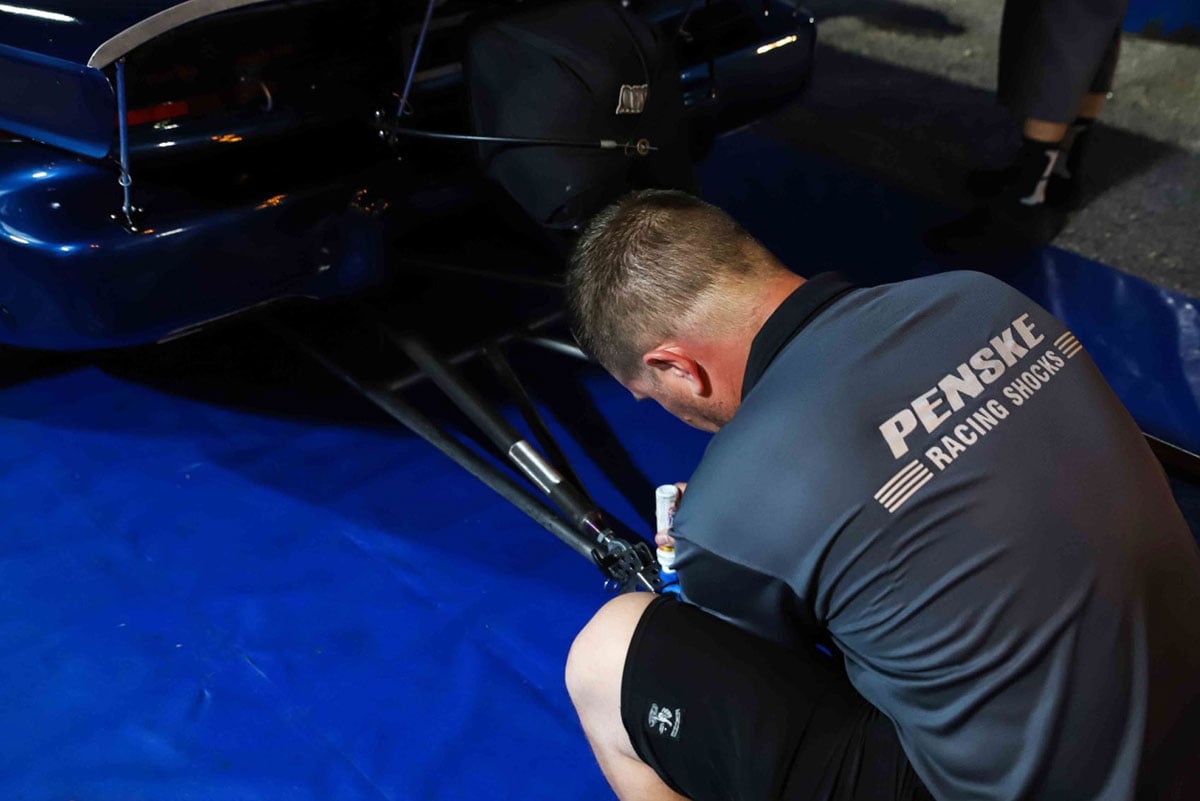Race Suspension Tuning Basics, 7 Things You Need to Know

November 15, 2021

Speed is king, right? Kind of. It’s certainly impressive to see a car take a long corner at breakneck speed, but what’s more impressive is seeing a car keep that speed seemingly effortlessly into a sharp corner without the driver feeling like the car might spin out of control.
Enter suspension.
When you watch racing on TV, you’ll notice the multitude of engineers intently staring at data screens, logging information, and receiving driver feedback, all to optimize the vehicle setup on race weekend.
It can be overwhelming to think about as there are many components and settings you could adjust to level up your performance, but you’ve decided to focus on tuning your suspension; great choice! Making adjustments to your suspension can yield improvements in lap times and make your ride more comfortable.
Knowing where to start can be daunting. You might have the best suspension components, but they need to be set up to work together optimally to give you the best performance.
7 Things You Need to Know About Race Suspension Tuning
You can think of suspension tuning as the final piece of the puzzle when it comes to setting up your vehicle. When your suspension is firing on all cylinders, your tires will stay in contact with the road or track in any situation.
If your suspension is improperly tuned, it could lead to handling problems, lost seconds on the track, and you’ll always have the feeling that something isn’t quite right.
You’ll see a marked improvement in your vehicle from nailing the basics of suspension tuning. Finding the perfect balance between comfort and performance takes work, but it’s worth the effort.
Learn more about the 5 Risks of Not Doing a Shock Rebuild Before the Race Season.
What is the Goal Of Suspension Tuning?
The true goal of suspension tuning is to improve how the car handles; in other words, its ability to maintain a course through turns, braking, different surfaces, and weather conditions. To keep the right course, you’ll start by Increasing ground contact or tire grip as you travel through a corner.
The Right Components
A suspension comprises tires, tire air, springs, and shocks that connect your vehicle to its wheels. It serves two purposes:
- Optimizing vehicle handling on the road
- Keeping your tires firmly planted on the ground
Manufacturers play a role here as they can provide parts optimized for your particular vehicle. Custom shocks and the ability to make adjustments with guided support are helpful when setting up your suspension.
Learn more about What Brand Of Racing Shocks Is Right For Me?
Get the Right Tools
You’ll need to test and retest, so it’s essential to record the changes you make - what works and what doesn’t. Knowing the baseline values of suspension means you’ll have a reference to work off of as you go. You’ll need:
- Tire pressure gauge
- Tire pyrometer
- Toe plates with tape measures
- Data system for lap times
- A notebook or binder to make notes
Having a notepad to store backup versions of your suspension settings will give you a whole season of logbook data. You’ll have a history of settings for various tracks and weather changes and the adjustments you make. You’ll also be able to return to your original settings just in case you want to start again.
Check out our FREE DOWNLOAD: Shock Build and Shock Setup/Lap Time Worksheet
In this free download, we provide both our Standard Shock Build Sheet, which is a great way to keep all your shock builds organized, and a Setup/Lap Time Sheet, a great tool to help improve your communication and record keeping of your chassis setup.
Figure Out What you NEED to Adjust
You know your car the best, and the most critical metric is how it drives and feels on the road or track.
- Do you know your power to weight ratio?
- Does your car tend to oversteer on certain turns and understeer on others?
- What’s your balance and weight distribution?
- What are your tire specs?
- What are the track conditions?
- Camber? Elevation?
Once you’ve made incremental adjustments, you can test and either go backward or make further adjustments. The most critical metric is adjustments based on your own experience, and your relationship to the car will level up your performance.
Think Smart, Not Fast
You need to find a balance between handling, braking, and power. Setting up for speed doesn’t make your car the fastest if it’s at the expense of acceleration and handling or grip in corners. Find a sweet spot.
Another tip for working smart is to start with the complex parts of a suspension setup like spring rates and ride height and work towards the more straightforward stuff like tire pressure. If, when you’re testing, things aren’t going to plan, work the other way.
Weather Changes
Your setup will change as the weather changes, and this is where having a logbook of adjustments will come in handy. The weather could change between races, and you need to cope with wet/dry weather and cold/hot weather.
Circuit Changes
Let’s say you just raced a circuit with long, fast straights and long, shallow corners, but your next race is full of short straights and tight corner sections; you’re going to alter your setup. The same applies to smooth or bumpy tracks.
Suspension Setup
Here’s a brief overview of your suspension setup and the adjustments you could make.
Ride height
Before you adjust your suspension, are you happy with the height of your car? Your suspension geometry is designed around the ride height.
Swaybar
Essentially, a sway bar connects your right and left side compression. As you hit a bump, the right side compresses, but the left doesn’t, which causes lean. A sway bar connects the two so that they both compress and are adjustable.
Camber Angle
Camber is the angle applied to the tires, and it alters the tires’ contact patch with the road.
Positive camber will produce a tendency towards oversteer. The car might hop during heavy acceleration. In corners, the rear end might lack grip and slide out. Tire wear increases with uneven wear on the outside tread.
Negative camber increases grip and stability in corners but might increase understeer. It is more predictable, however. Most race cars tend to be either straight or negative.
Toe
0 degrees of toe means the front wheels are perfectly straight with the steering wheel straight.
Toe in means the tires are closer together than at the back, and the car won’t turn as well, but it’s more stable at high speeds.
Toe out means the front tires are further away than the back, and the car will wander a bit more and turn a little better.
Shocks
You can adjust the damping force when your shock tries to compress and when it rebounds.
You can also adjust the speed of compression and rebound.
Low speed affects braking, accelerating, and turning. These are all smooth loads on the suspension, and you can adjust the resistance to those movements and loads.
High speed comes into play when you hit a bump or a rock. Your shock compresses quickly, and you can adjust the resistance to make the shock stiffer or faster/smoother.
Low and high-speed rebound is also adjustable. After you brake, does the car come up slowly or quickly? Similarly, how fast does the shock rebound after hitting a rock or going over a bump?
Tire Pressure
How much air is in your tires? It’s essential to think about adjustments you need to make with tire pressure because it’s temperature-dependent. You might start with 25 psi, but after going around a track 30 times, you might have 35 psi - it’s essential to consider this.
Brake Bias
How much brake pressure goes to the front and how much to the back? Different situations will determine how much you need to adjust.
Rough or Smooth?
Consider whether you’ll be on a rough or smooth track. Find out pre-race and make adjustments.
For example, you’ll probably want lower ride height and stiffer spring rates for better handling on a track, but on a rough road, you want high compression so that your car rebounds quickly after compressing. Depending on your application and how much you race will determine the adjustments you need to make.
These are basics, and making the necessary adjustments will provide you with improved performances. It’s best to start at factory settings and work from there, one step at a time.
Once you’ve set up your suspension and made adjustments, you’ll want to delve into problems you might run into, such as oversteer or understeer.
Check out our ON-DEMAND WEBINAR: Top 10 Most Common Suspension Issues & How to Resolve Them
In this free webinar, we review the most common suspension issues you're likely to encounter and tips for how you can resolve or avoid them altogether.
Digging Deeper Into Race Suspension Tuning
You’ve researched the various ways to adjust your suspension; now it’s time to think about where you’re sourcing your parts from. You can’t cut corners when it comes to components such as shocks and springs, and you’ll need race-specific shocks that offer excellent handling but also maintain good ride quality.
Penske Racing Shocks are customized to your vehicle and driving style. Experienced support is key to optimizing your suspension setup. You can speak to professional racers on the phone who have seen it all and want to help.
To find out more about Penske Racing Shocks, get in touch with our shock specialists here.


%20(1).png?width=1080&height=1080&name=Heritage%20Cruiser%20Shock%20-%20IG%20(1)%20(1).png)